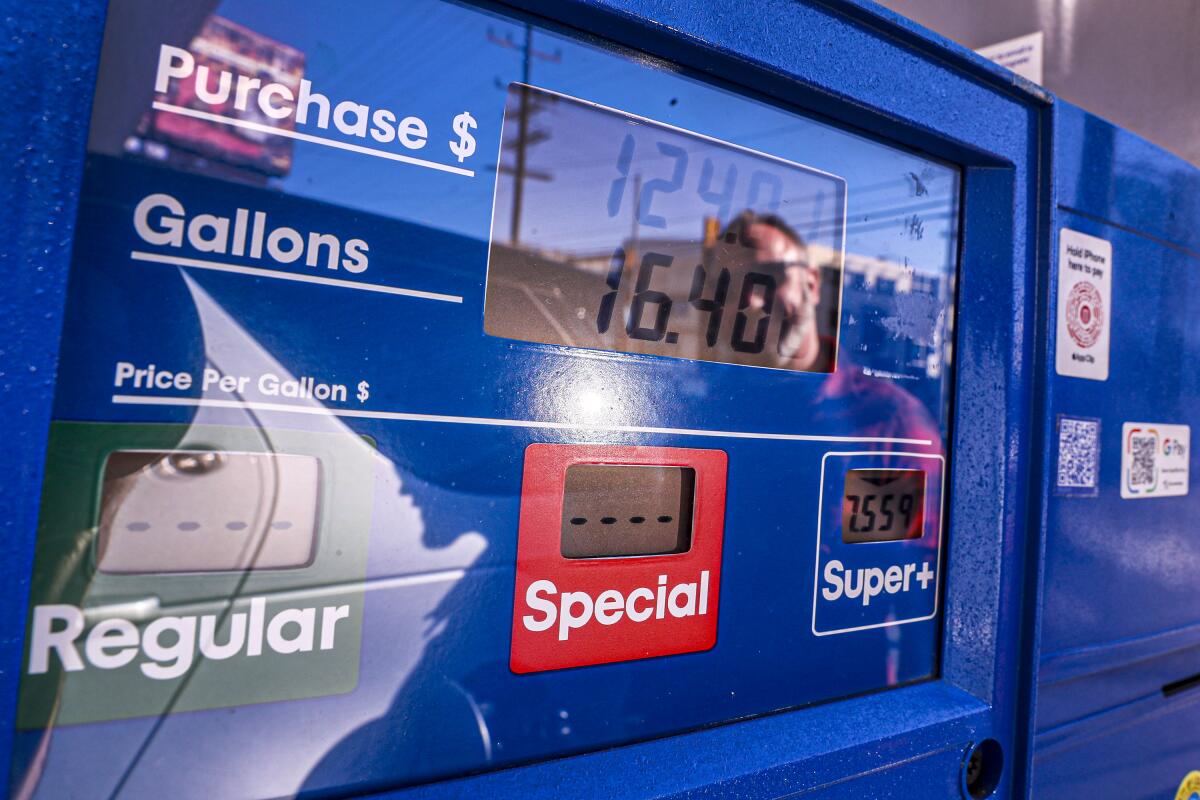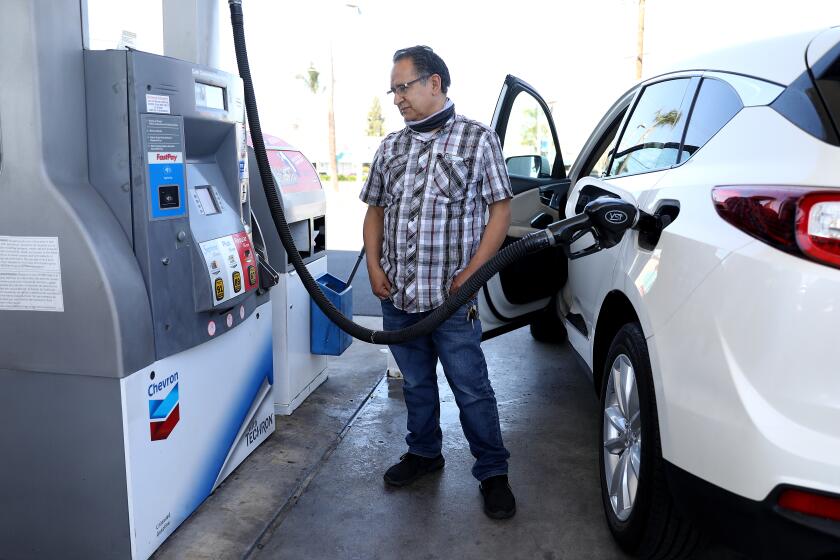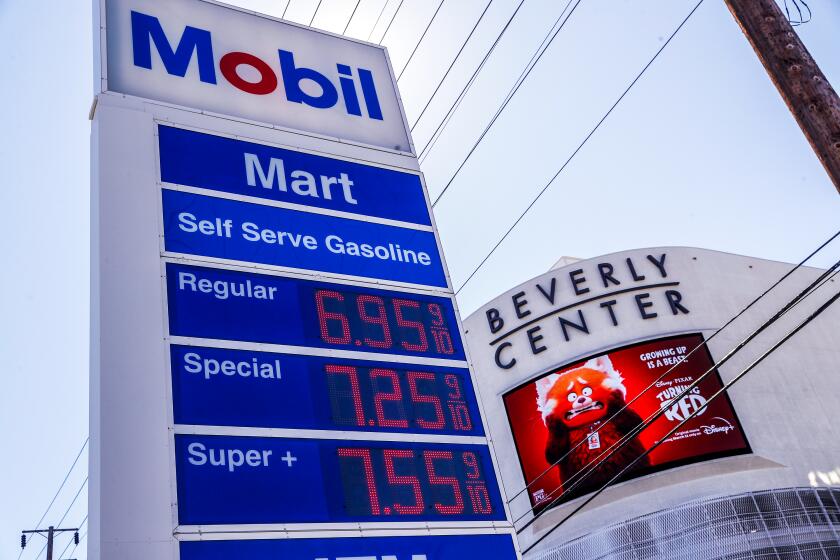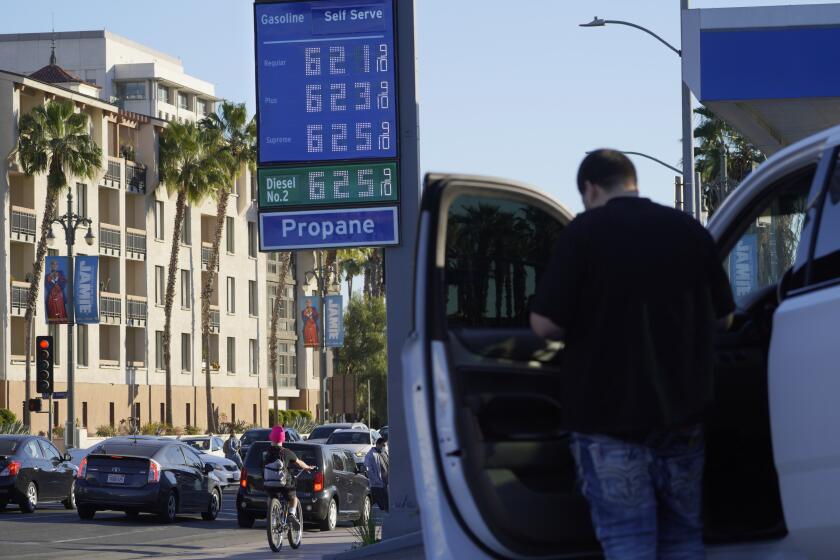Why California gas prices are so high and vary so widely: ‘Mystery surcharge’ and more

- Share via
You’re filling up your Toyota Camry at a gas station in Los Angeles County — home to six oil refineries that pump out more than a million barrels a day, nearly 60% of the refinery capacity in California. With so much oil so close to home, you might think gasoline would be pretty cheap.
You’d be wrong. With the average cost of gas in the county a wallet-busting $5.87 a gallon almost three weeks after Russia invaded Ukraine, a full tank would set you back $92.74.
That same tank of gas in tiny Yuba County — about 60 miles north of Sacramento, with no refineries and just 82,000 people — would cost on average nearly $6 less. Differences are more stark between California and other states and can even vary wildly from block to block.
No one factor drives these wide gasoline price gaps, but land prices are a big part of the equation in California. A combination of market forces, local differences and entrepreneurial prerogatives also helps determine prices from one filling station — or county — to the next.
Gas station proprietors, like other business owners, are free to charge whatever they want, as long as they don’t engage in illegal practices, such as price fixing or gouging. Branding and pricing strategies often come into play at this stage, said Patrick De Haan, head of petroleum analysis for GasBuddy.
In fact, lawmakers, consumer advocates and state investigators are looking into alleged price fixing in California and what impact that illegal practice may have on the amount consumers pay for gas at some name-brand stations.
Gas prices are high across California, and it’s unclear when prices will go down. But, there are ways to save money on gas. Here are some tips.
Some of the many factors that help define prices at the pump are more mundane. Rapid shifts in the wholesale price stations pay for gas can have an impact, as their purchasing schedules fail to keep up, De Haan said.
“Stations generally fill their underground tanks every 3-5 days, and with wholesale prices varying daily, and energy markets moving constantly, there’s a wide range in what stations themselves pay,” he said in an email.
And then there are land prices.
The Chevron station at 16801 Ventura Blvd. in Encino was charging $6.49 for a gallon of regular unleaded Wednesday afternoon. Less than two miles away, at the Savings gas station at 18076 Ventura Blvd., a gallon cost $5.49.
“Encino is difficult for business,” said Mike Shahri, who works at the Chevron station. “The real estate here is more expensive than many other areas.”
A related issue is convenience. Many consumers will pay slightly more per gallon if it means avoiding a U-turn at a busy intersection or not going out of their way, said Leo Feler, senior economist at the UCLA Anderson Forecast. Offering a specialty service or being the only game in town can also help support elevated prices, while having many competing stations can drive down gas prices in a given area.
At the other end of the spectrum, international events play a key role, even when they have yet to deplete national reserves or cause other significant crunches, Feler said.
“It’s been less than two weeks of sanctions on Russia … and gas prices are already increasing. How can that possibly be?” he said last week. “That’s because it’s all in anticipation of higher prices.”
And then there’s what UC Berkeley energy economist Severin Borenstein has dubbed the “mystery gas surcharge.”
For more than 20 years, California lawmakers and consumer advocacy groups have called for an investigation into why gas prices in California are consistently higher than prices in other states, even after accounting for taxation differences and the costs of adhering to the Golden State’s strict regulatory requirements.
More recently, much of their focus has shifted to questions about why certain name-brand gas stations often charge more than 30 cents more per gallon than stations with less prominent names.
In April 2019, Gov. Gavin Newsom asked the California Energy Commission to look into the prices drivers pay at the pump. In May 2019, state officials said “market manipulation” could be to blame for inflated prices.
That October, the California Energy Commission published a report that found that name-brand gas stations charge “higher prices for what appears to be the same product” and that “if competitors decide collectively to fix prices, this may be unlawful.”
The report, which left many key questions unanswered, called on the California Department of Justice to launch its own investigation into potential price fixing and false advertising by gas companies.
“It’s really astounding, the language [the CEC report] used: They’re charging higher prices because they can; it’s the same gasoline, but there’s nothing they can do about it,” Jamie Court, president of the Consumer Watchdog nonprofit advocacy group, said Thursday. “No one knows how much these guys are making when they process this crude into gasoline.”
You’ve seen the signs advertising $6.95, $6.99 or even $7.05 for a gallon of regular unleaded. But who’s buying it, and why?
Knowing the answer to that question could help shed a light on why California drivers pay a “mystery gas surcharge,” which Borenstein defined in a February 2020 blog post as “the premium of California gas prices above the rest of the US, AFTER accounting for the fact that we have higher taxes and environmental fees, and we use a cleaner gas formulation.”
As of Thursday, Borenstein said, the average mystery gas surcharge in California was 48 cents. That’s 17 cents higher than the average mystery surcharge in 2021, but only 1 cent higher than the average surcharge for December.
Kara Greene, a spokeswoman for the Western States Petroleum Assn., said an average of $1.27 of each gallon of gas sold in California goes to taxes, fees and climate programs. Of that amount, 10 cents on average goes toward state and local sales taxes, the latter of which can vary widely, Greene said.
“Municipalities are going to be different. Different places have different excise taxes and that’s the sales tax for gas,” she said. “I live in Sacramento, and they have a much higher sales tax for gasoline than another town might have.”
Borenstein said that while the industry group’s figures appear to be accurate, the mystery gasoline surcharge is a separate charge levied in addition to taxes, fees and climate program costs. And branded gas stations typically charge a disproportional amount more than unbranded ones in California, which drives prices even higher.
“The average differential is 7 cents in other parts of the country, and the average differential between branded and unbranded stations in California is 23 cents. That’s data from five years ago, but it makes the point,” he said in an interview Thursday.
“If people were to shop around more and go to those off-brand stations,” he said, “it would put pressure on the branded stations to lower their price. But Californians seem less willing to do that.”
Shortly after the CEC report was released in 2019, Newsom asked then-state Atty. Gen. Xavier Becerra to investigate alleged price fixing and other problematic practices in the oil and gas supply industry.
The California Energy Commission has concluded that “market manipulation” may be one factor in why the state’s gas prices are so high and has proposed a five-month study to pin down why motorists here pay more than those in the rest of the country.
At the time, Becerra’s office said it would launch an investigation, but in an email to The Times last week, the office — now run by Atty. Gen. Rob Bonta — said it could not comment on the investigation or confirm whether it exists, citing a need “to protect integrity.” Court and Borenstein both said the status of the investigation is unknown.
In May 2020, the attorney general’s office filed a lawsuit against two energy firms, Vitol Inc. and SK Energy Americas Inc. At the time, the office wrote that the “companies allegedly took advantage of [the] 2015 Torrance Refinery explosion to launch [a] scheme to raise gas prices statewide for their own profit,” ultimately “costing consumers more at the pump.”
In 2020, consumers also filed a string of lawsuits alleging price fixing and other improper activity by the two companies and a third, SK Trading International Co., that were combined into a single class-action suit.
Vitol and SK Energy Americas did not respond to requests seeking comment on the lawsuits.
Borenstein provided context on the increase in prices in his 2020 blog post. He explained that the mystery gasoline surcharge first appeared in the wake of the 2015 blast at an Exxon Mobil refinery in Torrance that injured four workers and resulted in $566,600 in penalties against the energy giant, and that it has persisted ever since.
Before the explosion, “California gasoline prices were higher than elsewhere in the U.S. by an amount that on average reflected the well-known taxes, fees and other cost factors,” he wrote. Gas prices spiked after the blast, but “unlike previous spikes, this one never disappeared. In 2015, it cost California drivers an extra $6.7 billion.”
The “fundamental problem” driving both California’s elevated gas prices and the premium at name-brand stations, according to Court, is that “when you have five refineries controlling 96% of the gasoline, you don’t have many options because when they squeeze you can’t do anything but wiggle.… They control the price at the pump.”
On Friday, state Sen. Ben Allen (D-Santa Monica) announced legislation to require refiners to publicize how much they pay for crude oil, how much it costs to refine that oil, and the amount of profit they make per gallon of gas they sell.
During a joint news conference with Consumer Watchdog and the California Public Interest Research Group on Friday morning, Allen, who drafted the bill, said data on how the oil and gas industry prices gasoline are “a big black hole.”
“What we’re trying to get at is what’s behind this mystery gas surcharge,” Allen said.
Kevin Slagle, a spokesman for the Western States Petroleum Assn., said in an email Friday that the organization was “still looking at the bill and may have more specific objections” to it in the coming days.
“[A]ny examination of costs at the pump,” he said, “should start with looking at California’s regulatory and tax environment.”
The hope for the legislation, Court said, is that such data would help officials and observers to determine how much profit the companies are making off high prices at the pump, and potentially help reveal any price fixing or other improper activity that may be taking place.
He cautioned that “it’s very hard to prove a price-fixing case” but said that if the legislation passes and refineries are found to have been taking too much profit, “we can claw it back with an excess profits tax. We can do a lot of things if we can understand how much it costs for them to produce the gasoline.”
The Fed is expected to raise its benchmark interest rate soon in an effort to slow inflation. Here’s what it can do and what effects that might have.
More to Read
Sign up for Essential California
The most important California stories and recommendations in your inbox every morning.
You may occasionally receive promotional content from the Los Angeles Times.















